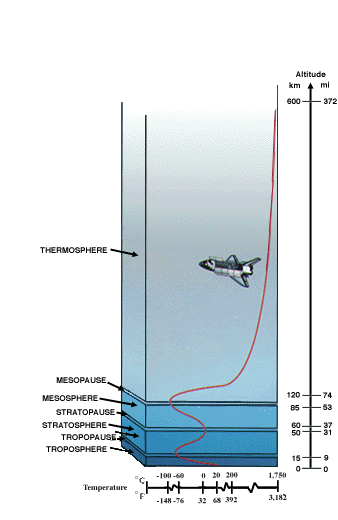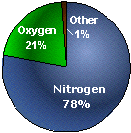Earth's Atmosphere
The Earth is surrounded by a blanket of air, which we call the atmosphere. It reaches over 560 kilometers (348 miles) from the surface of the Earth, so we are only able to see what occurs fairly close to the ground. Early attempts at studying the nature of the atmosphere used clues from the weather, the beautiful multi-colored sunsets and sunrises, and the twinkling of stars. With the use of sensitive instruments from space, we are able to get a better view of the functioning of our atmosphere.
Life on Earth is supported by the atmosphere, solar energy, and our planet's magnetic fields. The atmosphere absorbs the energy from the Sun, recycles water and other chemicals, and works with the electrical and magnetic forces to provide a moderate climate. The atmosphere also protects us from high-energy radiation and the frigid vacuum of space.
The envelope of gas surrounding the Earth changes from the ground up. Four distinct layers have been identified using thermal characteristics (temperature changes), chemical composition, movement, and density.

Troposphere
The troposphere starts at the Earth's surface and extends 8 to 14.5 kilometers high (5 to 9 miles). This part of the atmosphere is the most dense. As you climb higher in this layer, the temperature drops from about 17 to -52 degrees Celsius. Almost all weather is in this region. The tropopause separates the troposphere from the next layer. The tropopause and the troposphere are known as the lower atmosphere.
Stratosphere
The stratosphere starts just above the troposphere and extends to 50 kilometers (31 miles) high. Compared to the troposphere, this part of the atmosphere is dry and less dense. The temperature in this region increases gradually to -3 degrees Celsius, due to the absorbtion of ultraviolet radiation. The ozone layer, which absorbs and scatters the solar ultraviolet radiation, is in this layer. Ninety-nine percent of "air" is located in the troposphere and stratosphere. The stratopause separates the stratosphere from the next layer.
Mesosphere
The mesosphere starts just above the stratosphere and extends to 85 kilometers (53 miles) high. In this region, the temperatures again fall as low as -93 degrees Celsius as you increase in altitude. The chemicals are in an excited state, as they absorb energy from the Sun. The mesopause separates the mesophere from the thermosphere.
The regions of the stratosphere and the mesosphere, along with the stratopause and mesopause, are called the middle atmosphere by scientists. This area has been closely studied on the ATLAS Spacelab mission series.
Thermosphere
The thermosphere starts just above the mesosphere and extends to 600 kilometers (372 miles) high. The temperatures go up as you increase in altitude due to the Sun's energy. Temperatures in this region can go as high as 1,727 degrees Celsius. Chemical reactions occur much faster here than on the surface of the Earth. This layer is known as the upper atmosphere.
The upper and lower layers of the thermosphere will be studied more closely during the Tethered Satellite Mission (TSS-1R).
Composition of the Atmosphere

The atmosphere is primarily composed of Nitrogen (N2, 78%), Oxygen (O2, 21%), and Argon (Ar, 1%). A myriad of other very influential components are also present which include the water (H2O, 0 - 7%), "greenhouse" gases or Ozone (O<SUB3< SUB>, 0 - 0.01%), Carbon Dioxide (CO2, 0.01-0.1%),
Beyond the Atmosphere
The exosphere starts at the top to the thermosphere and continues until it merges with interplanetary gases, or space. In this region of the atmosphere, Hydrogen and Helium are the prime components and are only present at extremely low densities.
Wyszukiwarka
Podobne podstrony:
Fred Saberhagen Berserker 00 Earth Descended
Hollow Earth Expedition Inside the Drilling Machine
c 14 CONFIRMING THE YOUNG EARTH CREATION FLOOD MODEL
Essentials of Sociology A Down to Earth Approach aZ06 HENS 7052 PC
Earth Mover
Fred Saberhagen Earth's End Book of Swords 00 Song of Swords
Hollow Earth Expedition Addendum Characters
checklist earth
DiagnosingThe Earth
Teoretyczny model płaskiej Ziemii, Płaska Ziemia - Flat Earth
EARTH SONG
Hell on Earth Junker Extras
Hirneise, Lothar Chemotherapy Helps Cure Cancer, And The Earth Is Flat (Article, Ode 10 2003)(1)
Hollow Earth Expedition Character Sheet
Doat Hays Houben Matuk Vitous Building with Earth
How YOU Can Personally Defeat the NWO and Create Peace on Earth
13 Interoperability, data discovery and access The e infrastructures for earth sciences resources
Essentials of Sociology A Down to Earth Approach aZ04 HENS 7052 NI
Hollow Earth Expedition Target Atlantis
więcej podobnych podstron